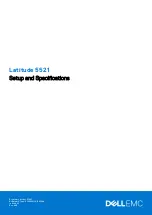
PDN Gateway Overview
Features and Functionality - Optional Enhanced Feature Software ▀
Cisco ASR 5x00 Packet Data Network Gateway Administration Guide ▄
83
MPLS Forwarding with LDP
Use of MPLS requires that a valid license key be installed. Contact your local Sales or Support representative for
information on how to obtain a license.
Multi Protocol Label Switching (MPLS) is an operating scheme or a mechanism that is used to speed up the flow of
traffic on a network by making better use of available network paths. It works with the routing protocols like BGP and
OSPF, and therefore it is not a routing protocol.
MPLS generates a fixed-length label to attach or bind with the IP packet's header to control the flow and destination of
data. The binding of the labels to the IP packets is done by the label distribution protocol (LDP). All the packets in a
forwarding equivalence class (FEC) are forwarded by a label-switching router (LSR), which is also called an MPLS
node. The LSR uses the LDP in order to signal its forwarding neighbors and distribute its labels for establishing a label
switching path (LSP).
In order to support the increasing number of corporate APNs, which have a number of different addressing models and
requirements, MPLS is deployed to fulfill at least the following two requirements:
The corporate APN traffic must remain segregated from other APNs for security reasons.
Overlapping of IP addresses in different APNs.
When deployed, the MPLS backbone automatically negotiates routes using the labels binded with the IP packets. Cisco
P-GW as an LSR learns the default route from the connected provider edge (PE), while the PE populates its routing
table with the routes provided by the P-GW.
Important:
For more information on MPLS support, refer to the
Multi-Protocol Label Switching (MPLS)
Support
appendix in this guide.
NEMO Service Supported
Use of NEMO requires that a valid license key be installed. Contact your local Sales or Support representative for
information on how to obtain a license.
The P-GW may be configured to enable or disable Network Mobility (NEMO) service.
When enabled, the system includes NEMO support for a Mobile IPv4 Network Mobility (NEMO-HA) on the P-GW
platform to terminate Mobile IPv4 based NEMO connections from Mobile Routers (MRs) that attach to an Enterprise
PDN. The NEMO functionality allows bi-directional communication that is application-agnostic between users behind
the MR and users or resources on Fixed Network sites.
The same NEMO4G-HA service and its bound Loopback IP address supports NEMO connections whose underlying
PDN connection comes through GTP S5 (4G access) or PMIPv6 S2a (eHRPD access).
Important:
For more information on NEMO support, refer to the
Network Mobility (NEMO)
chapter in this
guide.
NEMO Support in GGSN
Use of Dynamic Network Mobile Routing (NEMO) for GGSN requires that a valid license key be installed. Contact
your Cisco account representative for information on how to obtain a license.
NEMO support in P-GW was added in earlier StarOS releases. In release 15.0, support was added for GGSN as well so
that NEMO can be supported for subscribers roaming out on 3G (UMTS/GERAN) networks.
















































